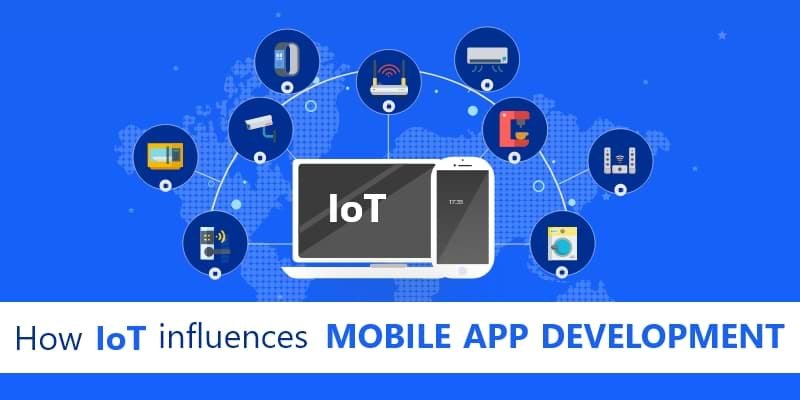How Internet of Things (IoT) Influences Mobile Application Development Now a days
As experts in software, web, and mobile development, it’s our job to stay up-to-date on digital trends. Lately, we’ve worked on a number of projects that combine mobile projects with IoT.
Managers seeking to manage their IoT networks look to mobile apps as a convenient solution. The market share of IoT is projected to reach $520 billion by 2021, according to Bain. As it expands, it will continue to influence mobile app development.
In fact, out of the 29 billion IoT objects expected for 2022, 1.5 billion of them will connect with mobile devices. The amount of mobile connections is portrayed in orange on the graph.
Based on our experience with many of these industries, we’ve identified six primary ways that IoT will continue to influence mobile app development.
- The Prevalence of Enterprise IoT Apps Will Increase
IoT devices collect a wealth of data that’s useful to enterprises. Here are a few common use-cases of IoT-enabled apps:
- Supply chain wearables to track productivity, employee health, and physical movement
- Office automation monitors temperature and lighting
- Internet-enabled vehicles provide logistics data such as fuel use, speed, and delays
Data gathered from office IoT devices can help executives make decisions regarding their organizational strategy. As the benefits of this technology become more well-known, demand for these IoT-enabled apps will increase within enterprises.
- IoT Application Development Frameworks Must Be Used
Just any app development framework won’t work for IoT-enabled mobile apps. It has to be an IoT application development framework.
There are many IoT frameworks available to solution providers. Each one brings unique benefits to different mobile applications.
For instance, the Nerves IoT framework allows programmers to build Elixir software. It has a security feature called NervesHub to manage security updates of devices in the network.
Before selecting a framework, programmers should outline which software they plan on using and their cybersecurity goals.
- Mobile Apps Will Become More Personalized
User-centric information collected from IoT devices can be used to personalize users’ in-app experience. IoT networks can send information in real-time to mobile solutions.
For instance, smart kitchen devices such as the smart meat thermometer below can deliver individualized data to cooking or dieting apps.
This dynamic flow of personalized information to customers’ phones will help make IoT apps an important part of users’ daily lives.
IoT app developers must ensure mobile apps have a robust ability to analyze user data and alter functionality accordingly. The more data collected, the more individualized the app will become.
- Security Will Remain a Priority for IoT Mobile Apps
Security has always been a concern for IoT devices. Internet-enabled objects just offer another entrance point for hackers, and mobile devices compound that risk.
IoT devices in the workplace often collect confidential information such as transaction history and employee behavior. For example, a smart printer could transmit data from confidential documents to a cellular device.
Cybersecurity practices for IoT devices aren’t widely known, and they are more difficult to update than desktops. Therefore, mobile app development companies should make sure their clients understand the security risks of IoT devices before launching their mobile solution.
- IoT-Enabled Apps Run the Risk of Losing Accessibility
If IoT-enabled apps aren’t programmed with care, the complexity of integrating IoT features could hurt the app’s functionality.
Developers will be focused on the security of the device and its potential to connect with more IoT devices in the future. However, programmers must remember to prioritize the solution’s UI/UX while integrating the additional devices.
The less “new learning” a user has to do after downloading an IoT-enabled app, the more engaged they will be. Ultimately, IoT app solution providers can’t forget about the user experience.
- IoT-Enabled Apps Hold Potential for Innovation
The augmented functionality of IoT-enabled apps means there’s more room to play with user interaction. IoT is still an emerging technology, and its capability won’t stop expanding anytime soon.
Data from IoT objects can be reported in a variety of innovative ways, and it can inform other features of the mobile app. For instance, there are opportunities to incorporate machine learning (ML) and artificial intelligence (AI) into the solutions.
Developers must approach app development with an open mind if they want to take full advantage of the opportunities an IoT connection will bring.
- IoT Has the Power to Enhance Mobile Apps
When mobile apps connect to IoT devices, they become more complex and more useful. An app can benefit your business strategy and increase the amount of personalization you provide your customers. However, incorporating IoT can also bring security risks and the potential for a less-friendly UX.
The right company will identify and seize the endless opportunities for innovation that IoT brings to mobile app development.


